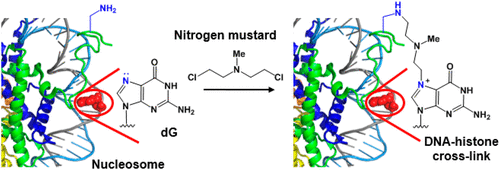当前位置:
X-MOL 学术
›
Chem. Res. Toxicol.
›
论文详情
Our official English website, www.x-mol.net, welcomes your
feedback! (Note: you will need to create a separate account there.)
Nitrogen Mustard Induces Formation of DNA-Histone Cross-Links in Nucleosome Core Particles.
Chemical Research in Toxicology ( IF 3.7 ) Pub Date : 2019-11-21 , DOI: 10.1021/acs.chemrestox.9b00354 Mengdi Shang 1 , Mengtian Ren 1 , Chuanzheng Zhou 1
Chemical Research in Toxicology ( IF 3.7 ) Pub Date : 2019-11-21 , DOI: 10.1021/acs.chemrestox.9b00354 Mengdi Shang 1 , Mengtian Ren 1 , Chuanzheng Zhou 1
Affiliation

|
Nitrogen mustards have long been used in cancer chemotherapy, and their cytotoxicity has traditionally been attributed to the formation of DNA interstrand cross-links and DNA monoalkylation. Recent studies have shown that exposure to nitrogen mustards also induces the formation of DNA-protein cross-links (DPCs) via bridging between N7 of a deoxyguanosine residue in the DNA and the side chain of a Cys residue in the protein. However, the formation of nitrogen mustard-induced DNA-histone cross-links has never been observed. Herein, we demonstrate that treating reconstituted nucleosome core particles (NCPs) with the nitrogen mustard mechlorethamine results in the formation of DNA-histone cross-links in addition to DNA monoalkylation and interstrand cross-link formation. The yields of these three types of DNA lesions in the NCPs decreased in the following order: DNA monoalkylation ≫ DNA interstrand cross-links > DNA-histone cross-links. Mechanistic studies involving tailless histones and competitive inhibition by a polyamine demonstrated that Lys residues in the N- and C-terminal tails of the histones were the predominant sites involved in DNA-histone cross-link formation. Given that NCPs are the fundamental repeating units of chromatin in eukaryotes, our findings suggest that nitrogen mustard-induced formation of DNA-histone cross-links may occur in living cells and that DPC formation may contribute to the cytotoxicity of nitrogen mustards.
中文翻译:

氮芥末诱导核小体核心颗粒中DNA组蛋白交联的形成。
氮芥子气已长期用于癌症化学疗法,其细胞毒性传统上归因于DNA链间交联的形成和DNA单烷基化。最近的研究表明,暴露于氮芥末还通过桥接DNA中脱氧鸟苷残基的N7和蛋白质中Cys残基的侧链,诱导了DNA-蛋白质交联(DPC)的形成。然而,从未观察到氮芥子诱导的DNA-组蛋白交联的形成。在这里,我们证明用氮芥菜甲氧乙胺处理重组核小体核心颗粒(NCPs)会导致DNA-组蛋白交联的形成以及DNA单烷基化和链间交联的形成。NCP中这三种类型的DNA损伤的产量按以下顺序降低:DNA单烷基化≫ DNA链间交联> DNA-组蛋白交联。涉及无尾组蛋白和多胺竞争抑制的机理研究表明,组蛋白N和C末端尾巴中的Lys残基是DNA-组蛋白交联形成的主要位点。鉴于NCP是真核生物中染色质的基本重复单元,我们的发现表明,在活细胞中可能发生氮芥诱导的DNA-组蛋白交联的形成,而DPC的形成可能对氮芥的细胞毒性作出贡献。涉及无尾组蛋白和多胺竞争抑制的机理研究表明,组蛋白N和C末端尾巴中的Lys残基是DNA-组蛋白交联形成的主要位点。鉴于NCP是真核生物中染色质的基本重复单元,我们的发现表明,在活细胞中可能发生氮芥诱导的DNA-组蛋白交联的形成,而DPC的形成可能对氮芥的细胞毒性作出贡献。涉及无尾组蛋白和多胺竞争抑制的机理研究表明,组蛋白N和C末端尾巴中的Lys残基是DNA-组蛋白交联形成的主要位点。鉴于NCP是真核生物中染色质的基本重复单元,我们的发现表明,在活细胞中可能发生氮芥诱导的DNA-组蛋白交联的形成,而DPC的形成可能对氮芥的细胞毒性作出贡献。
更新日期:2019-11-22
中文翻译:

氮芥末诱导核小体核心颗粒中DNA组蛋白交联的形成。
氮芥子气已长期用于癌症化学疗法,其细胞毒性传统上归因于DNA链间交联的形成和DNA单烷基化。最近的研究表明,暴露于氮芥末还通过桥接DNA中脱氧鸟苷残基的N7和蛋白质中Cys残基的侧链,诱导了DNA-蛋白质交联(DPC)的形成。然而,从未观察到氮芥子诱导的DNA-组蛋白交联的形成。在这里,我们证明用氮芥菜甲氧乙胺处理重组核小体核心颗粒(NCPs)会导致DNA-组蛋白交联的形成以及DNA单烷基化和链间交联的形成。NCP中这三种类型的DNA损伤的产量按以下顺序降低:DNA单烷基化≫ DNA链间交联> DNA-组蛋白交联。涉及无尾组蛋白和多胺竞争抑制的机理研究表明,组蛋白N和C末端尾巴中的Lys残基是DNA-组蛋白交联形成的主要位点。鉴于NCP是真核生物中染色质的基本重复单元,我们的发现表明,在活细胞中可能发生氮芥诱导的DNA-组蛋白交联的形成,而DPC的形成可能对氮芥的细胞毒性作出贡献。涉及无尾组蛋白和多胺竞争抑制的机理研究表明,组蛋白N和C末端尾巴中的Lys残基是DNA-组蛋白交联形成的主要位点。鉴于NCP是真核生物中染色质的基本重复单元,我们的发现表明,在活细胞中可能发生氮芥诱导的DNA-组蛋白交联的形成,而DPC的形成可能对氮芥的细胞毒性作出贡献。涉及无尾组蛋白和多胺竞争抑制的机理研究表明,组蛋白N和C末端尾巴中的Lys残基是DNA-组蛋白交联形成的主要位点。鉴于NCP是真核生物中染色质的基本重复单元,我们的发现表明,在活细胞中可能发生氮芥诱导的DNA-组蛋白交联的形成,而DPC的形成可能对氮芥的细胞毒性作出贡献。











































 京公网安备 11010802027423号
京公网安备 11010802027423号